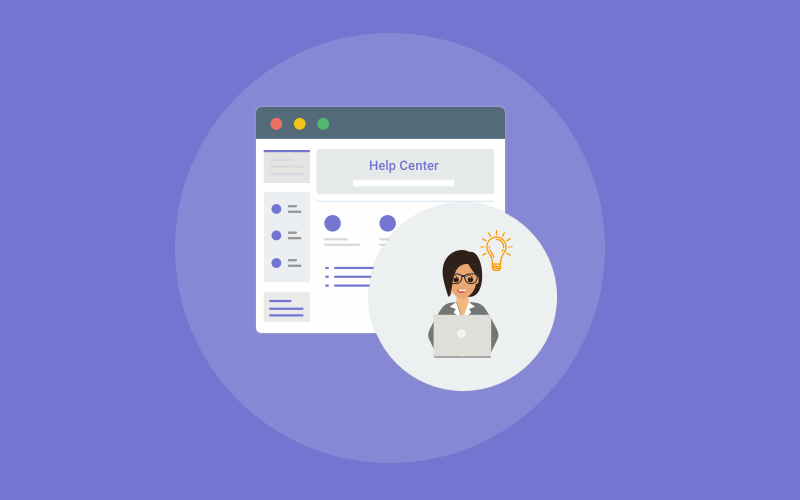
Organizations face the risk of knowledge loss when talented employees retire, resign, or are sacked.
The insights and expertise they gain during their tenure is an enormous asset. In an interdependent work culture, this knowledge loss may lead to a more inefficient workforce and potentially broken internal processes.
You might have seen managers hustle at the last minute to ensure a smooth handover process when a key employee leaves.
But, is this official handover enough to capture all of the valuable knowledge possessed by that employee?
Most of the time, you’re just able to scratch the surface!
That’s where knowledge transfer steps in. It is a continuous process that involves storing, managing, and sharing employees’ institutional knowledge on a centralized platform.
In this blog, we will dig into this concept in detail, understand its importance, and explore the process of creating a successful knowledge base plan.
Let’s learn how to capture the wealth of information employees hold in their heads before they bid you goodbye!
What Is Knowledge Transfer?
Knowledge transfer is a well-defined process of capturing and storing employees’ valuable knowledge on a centralized platform, so it can be easily accessed by everyone in your organization. Regardless of who leaves and who joins, the knowledge employees gain in their tenure stays with you forever.
This central source of information eliminates the hassle of digging through emails, documents, and Google Drive, thus improving workforce productivity.
Why Is Knowledge Transfer Important for Your Business?
Now that you are aware of the knowledge transfer definition let’s dig a little deeper and unearth the reasons you should implement it in your organization.
Did you know that over 4.3 million people left their jobs in December 2021, according to the U.S. Bureau of Labor Statistics? And this number is only expected to increase in the coming years!
While talent loss is itself huge, what’s even more detrimental is the knowledge that goes out the door as employees leave.
Think of all the complicated handover processes that are undertaken every time an employee resigns!
Such a pain, right?
The pain amplifies when you are able to capture only a fraction of the knowledge the employee holds, due to lack of time. It’s a huge loss that affects operational efficiency and workforce productivity, stunts innovation, and even hinders the employee onboarding process.
Therefore, it’s vital for departing employees to pass the torch to others so that their absence doesn’t hamper the existing processes or tasks. And everything runs smoothly just like before!
By adopting different methods of knowledge transfer, you can ensure that the knowledge amassed by employees in their tenure always stays with you!
In addition, there are many other benefits you can glean by implementing knowledge transfer, such as:
- Fosters knowledge sharing culture in your organization
- Speeds up employee onboarding by giving new hires quick access to subject matter expertise and company best practices
- Spares existing employees from digging through emails, files, and Google Drive to get what they need
- Helps you build and maintain knowledge assets for your existing and future employees
Different Uses of Knowledge Transfer
While most experts will give you the answer to what is knowledge transfer, there will be very few who will be able to divulge the details of —
How does knowledge transfer work!
Well, you will not be disappointed here as we did our research and have collated all the possible ways knowledge transfer can be used.
The uses of knowledge transfer and knowledge sharing platforms are manifold. Let’s look at some of the most significant ones:
- Equips employees with instant access to department-specific best practices and subject matter expertise
- Treats each employee as a valuable resource whose contributions can bring real value to your business
- Reduces the occurrence of repetitive errors in performing tasks and conducting processes
- Relieves employees from the tedious task of searching for information scattered across emails, excel sheets, and PPTs
- Boosts workforce efficiency by giving 24×7 access to company knowledge
All of this combined has a snowball effect on how your business operates and grows. From customer service to sales and marketing, there is a positive impact on each department and an increased scope for innovation.
How to Achieve Effective Knowledge Transfer
For systematic knowledge transfer, start by creating a knowledge sharing culture where employees come together and share their insights and experiences. Next, you need to document, organize, and improve this knowledge from time to time.
Let’s look at these steps in detail.
1. Build a System to Capture Knowledge
A knowledge-sharing culture is crucial for successful knowledge transfer.
You need to focus on initiating activities that promote this culture. Put efforts into bringing your teams together and ask them to share their expertise and experiences.
You can organize brainstorming sessions for knowledge transfer, ask for solutions to business problems, and involve subject-matter experts in the process. Take insights from department heads and those who have been working in your organization for a long time. Veteran employees can also take training sessions that help spark meaningful conversations in teams.
As a company that values knowledge, your goal should be to create a centralized repository of all the captured information so it never gets lost.
Now, the question here is, how to document this information and let employees access it whenever they need?
The next step holds the answer!
2. Store Information in an Internal Knowledge Base
A cloud-based knowledge base is all you need to safely store all the captured information.
It equips your teams with the necessary infrastructure to create helpful articles enriched with images and videos. A knowledge base is a great platform to document both explicit and tacit knowledge that saves employees from the chaos of emails and Google Drives.
What’s really fascinating about this platform is its ease of access. Employees can get everything they need in a heartbeat. No juggling between multiple docs. Just one platform where they can find all insights and best practices.
With knowledge at their fingertips, employees can work more efficiently and make informed decisions on time.
Here’s a quick video on how you can create an internal knowledge base and expedite the transfer of knowledge.
3. Share Knowledge With Multiple Teams
For your knowledge transfer system to be really useful, it should be accessible to everyone. Ease of access is an important factor that decides how frequently your teams will be using this system.
You need a well-defined process that facilitates quick knowledge transfer to new employees as well as existing ones. Start by creating a process document stating the key rules of knowledge sharing that employees must follow.
Building a dedicated team of knowledge transfer specialists who can oversee the entire process from start to end. This team will make key decisions regarding which channels to include and which teams to cover. Additionally, the team will be responsible for the timely dissemination of information.
Along with this, you also need the support of the right knowledge transfer software that can accelerate the process of information circulation and ensure it’s done at a deeper level, covering all departments and teams.
4. Measure Knowledge Transfer Success
Once you are done documenting and disseminating information, the next step is to measure the success of your knowledge transfer process.
The ultimate goal of knowledge transfer is to capture knowledge from key employees and create a factory of valuable information. If you don’t update this database from time to time, it can turn stale and useless.
Keeping a constant check on how information is being used is therefore important. By deploying a powerful knowledge management tool, you can track KPIs and measure the effectiveness of the content. With KPIs like article upvotes and downvotes, failed and successful searches, it’s possible to identify what’s working and what’s not working with employees.
Use this data to understand what your employees are looking for and whether they are finding the right answers. Based on your analysis, ask your department heads or subject matter experts to revise irrelevant articles and create educational content on the topics employees are searching for.
Watch this video to learn more about how to track KPIs and enhance your knowledge transfer system.
How to Create a Knowledge Transfer Plan
Many of you might have questions on what is a knowledge transfer plan and how you can create one for your business.
A knowledge transfer plan lays the foundation for circulating knowledge effectively across your organization. It gives you a defined path to channeling your efforts and achieving the maximum results from your knowledge transfer initiatives.
Follow these simple steps to create a result-focused knowledge transfer plan:
1. Set Clear Goals
This is the very first thing you need to do while creating a knowledge transfer plan. To gain clarity regarding your goals, you need to ask yourself questions like:
- Are most of our employees on the verge of retirement?
- What is the percentage of new employees in the organization?
- Is the existing knowledge-sharing system not efficient?
- Is there a lack of innovation in some processes?
Analyze the current state of your business, come up with more questions, and wear your thinking hat to reach the right answers.
This will help you come to a conclusion as to why exactly you need a knowledge transfer system. For instance, if a substantial portion of your employees is going to retire in the next three years, you will need a knowledge transfer system to capture and preserve their wisdom.
2. Identify Employees With Deep Industry Knowledge
These will most likely be employees holding critical positions in your company and those working with you for a long time. Knowledge holders can also be lower-echelon employees who are new to the industry but have unique insights that can be useful for your organization.
Track the previous performance of employees, their contributions in respective departments, and the credentials they hold to identify your top employees. Make a list of these individuals and give them the opportunity to share their wisdom.
Go through their past accomplishments to identify what they can bring to the table and what difference they can make in your organization.
3. Identify the Information to be Captured
There is no end to the amount of knowledge a seasoned employee holds. But can you really capture all of that information?
That’s not practically possible!
It’s crucial to identify the information you would want to make available for your teams. The best way to do that is by directly asking employees about what they really need.
For example, you can connect with the sales team to understand their pain points.
- Do they find it challenging to add customer data to your CRM?
- Are they well-versed with the sales process followed in your company?
- Are they familiar with all the sales policies and their significance?
- Do they know the process to escalate customer issues?
There can be several other questions you can ask your sales team to get the right answers. You should repeat the same process with your product, marketing, and various other departments.
Analyze the responses and jot down the key topics that must be covered in your knowledge transfer system. Work together with your top employees to add other hot topics that can help teams work more efficiently.
4. Adopt the Right Tool for Knowledge Transfer
Without the support of the right tools, your knowledge transfer attempts will continue to fail.
Once you have identified the information to be captured, you also need to look for the platform where the actual knowledge transfer can take place. You can’t expect employees to keep saving information in Google Docs or emails. That would be counterproductive, with employees feeling more burdened.
As several employees will be participating in knowledge transfer sessions, it’s to adopt the right tool that facilitates collaborative information sharing.
Modern knowledge management tools help you build a centralized platform where articles can be created, stored, and accessed on the go. They allow you to maintain multiple versions of the articles, keep track of all changes, and even save the content as a PDF or ebook for later use.
Collaboration is an interesting feature of this tool. Multiple teams can work together to create articles with no confusion or chaos.
This is highly beneficial, as collaborative content creation is one of the most crucial knowledge transfer steps, without which the process remains incomplete.
5. Familiarize Employees With Your Knowledge Transfer Platform
If employees aren’t acquainted with how your knowledge transfer platform functions, they will resort to the same old methods of finding the information they need. The conventional methods of asking questions via emails, calls, or in-person will continue, and your investment to implement knowledge transfer will be futile.
Therefore, you need to focus on knowledge transfer training to get employees up to speed with the new ways of working. Ask department heads to take sessions with their respective teams and make them aware of the benefits of using the knowledge base.
Explain to employees how they can be super productive and innovative if they leverage the knowledge transfer system. Give demonstrations on how and when a knowledge transfer system can be used to work more efficiently.
Breaking old habits and adopting new ones can be challenging at first. It might take your employees some time to fully accept and understand knowledge transfer, but as they realize the benefits it offers, there will be no looking back.
6. Match the Results With Your Goals
Keep a constant eye on the results you receive by adopting the knowledge transfer system. Go back to the goals you had set in the beginning and analyze what outcomes you have accomplished. Your goals can be anything from preventing knowledge loss and improving the onboarding process to driving creativity across departments.
Review the results from time to time to assess the effectiveness of your knowledge transfer plan. It will help you identify bottlenecks in the plan and make the required alterations to achieve the results you want.
Another way is to conduct a Q&A session with teams to take their feedback and identify areas of improvement. Employees can share their suggestions on what they like about the new knowledge transfer system and how it can be further enhanced.
Reviewing and evaluating the results should be a continuous endeavor aimed at spotting and fixing the roadblocks on time before they cause any irreparable damage.
Implement Knowledge Transfer to Boost Innovation, Productivity, & Collaboration
Knowledge transfer is not a one-day process. It takes considerable time and effort to capture and store the vast knowledge held by key personnel of your organization.
There is definitely no magic formula to implement knowledge transfer, but following the right steps and having a well-defined plan in place can set you up for success. Additionally, you also need the support of a solid knowledge management tool to drive your efforts in the right direction. All of this together will help you accomplish a seamless knowledge transfer system that aids collaboration, boosts knowledge sharing, and improves workforce productivity.
ProProfs Knowledge Base Software can be a great help in this process with its ease of use, powerful content creation features, and built-in reporting system. So, whatever your knowledge transfer goal is, you can rely on ProProfs to help you implement the process with absolute ease.
Do you want a free Knowledge Base?
We have the #1 Online Knowledge Base Software for instant self-help







